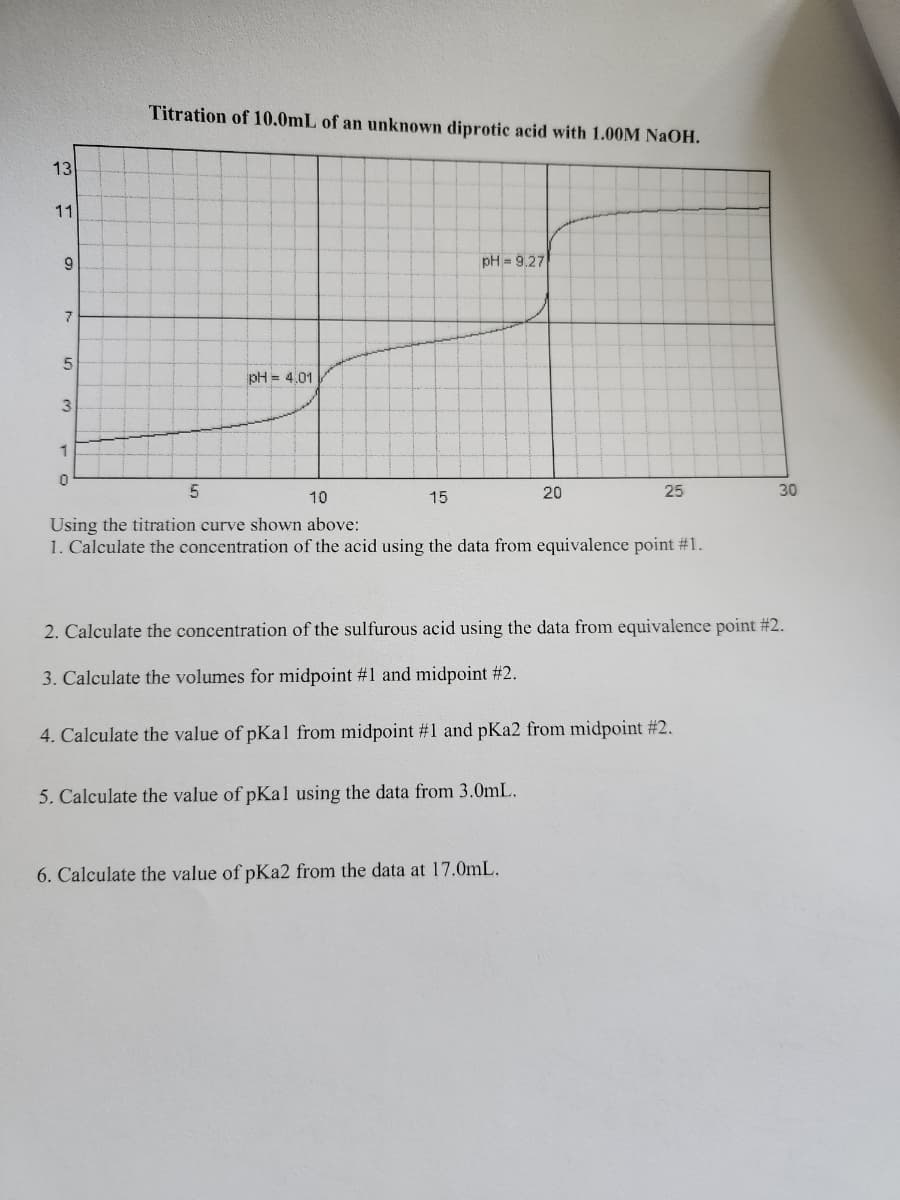13 11 9 7 5 3 1 0 Titration of 10.0mL of an unknown diprotic acid with 1.00M NaOH. 5 pH = 4.01 15 pH=9,27 10 Using the titration curve shown above: 1. Calculate the concentration of the acid using the data from equivalence point #1. 20 5. Calculate the value of pKal using the data from 3.0mL. 25 6. Calculate the value of pKa2 from the data at 17.0mL. 2. Calculate the concentration of the sulfurous acid using the data from equivalence point #2. 3. Calculate the volumes for midpoint #1 and midpoint #2. 4. Calculate the value of pKal from midpoint #1 and pKa2 from midpoint #2. 30
13 11 9 7 5 3 1 0 Titration of 10.0mL of an unknown diprotic acid with 1.00M NaOH. 5 pH = 4.01 15 pH=9,27 10 Using the titration curve shown above: 1. Calculate the concentration of the acid using the data from equivalence point #1. 20 5. Calculate the value of pKal using the data from 3.0mL. 25 6. Calculate the value of pKa2 from the data at 17.0mL. 2. Calculate the concentration of the sulfurous acid using the data from equivalence point #2. 3. Calculate the volumes for midpoint #1 and midpoint #2. 4. Calculate the value of pKal from midpoint #1 and pKa2 from midpoint #2. 30
Chemistry: Principles and Reactions
8th Edition
ISBN:9781305079373
Author:William L. Masterton, Cecile N. Hurley
Publisher:William L. Masterton, Cecile N. Hurley
Chapter14: Equilibria In Acid-base Solutions
Section: Chapter Questions
Problem 74QAP: Fifty cm3 of 1.000 M nitrous acid is titrated with 0.850 M NaOH. What is the pH of the solution (a)...
Related questions
Question

Transcribed Image Text:13
11
9
7
5
3
1
0
Titration of 10.0mL of an unknown diprotic acid with 1.00M NaOH.
5
pH = 4.01
15
pH = 9,27
10
Using the titration curve shown above:
1. Calculate the concentration of the acid using the data from equivalence point #1.
20
25
. Calculate the value of pKa2 from the data at 17.0mL.
30
2. Calculate the concentration of the sulfurous acid using the data from equivalence point #2.
3. Calculate the volumes for midpoint #1 and midpoint #2.
4. Calculate the value of pKal from midpoint #1 and pKa2 from midpoint #2.
5. Calculate the value of pKal using the data from 3.0mL.
Expert Solution
This question has been solved!
Explore an expertly crafted, step-by-step solution for a thorough understanding of key concepts.
This is a popular solution!
Trending now
This is a popular solution!
Step by step
Solved in 2 steps with 1 images

Knowledge Booster
Learn more about
Need a deep-dive on the concept behind this application? Look no further. Learn more about this topic, chemistry and related others by exploring similar questions and additional content below.Recommended textbooks for you

Chemistry: Principles and Reactions
Chemistry
ISBN:
9781305079373
Author:
William L. Masterton, Cecile N. Hurley
Publisher:
Cengage Learning

Chemistry: An Atoms First Approach
Chemistry
ISBN:
9781305079243
Author:
Steven S. Zumdahl, Susan A. Zumdahl
Publisher:
Cengage Learning


Chemistry: Principles and Reactions
Chemistry
ISBN:
9781305079373
Author:
William L. Masterton, Cecile N. Hurley
Publisher:
Cengage Learning

Chemistry: An Atoms First Approach
Chemistry
ISBN:
9781305079243
Author:
Steven S. Zumdahl, Susan A. Zumdahl
Publisher:
Cengage Learning


Chemistry
Chemistry
ISBN:
9781305957404
Author:
Steven S. Zumdahl, Susan A. Zumdahl, Donald J. DeCoste
Publisher:
Cengage Learning

Chemistry: Principles and Practice
Chemistry
ISBN:
9780534420123
Author:
Daniel L. Reger, Scott R. Goode, David W. Ball, Edward Mercer
Publisher:
Cengage Learning

Chemistry: The Molecular Science
Chemistry
ISBN:
9781285199047
Author:
John W. Moore, Conrad L. Stanitski
Publisher:
Cengage Learning